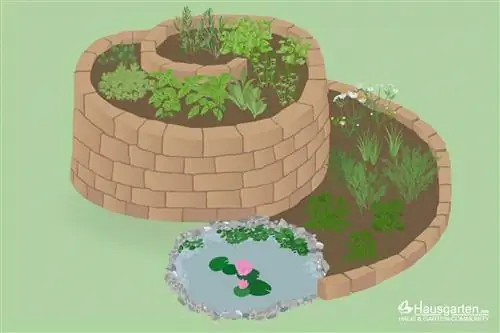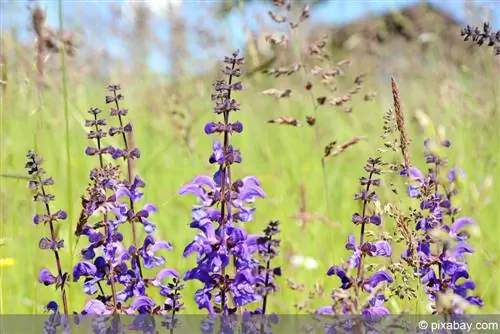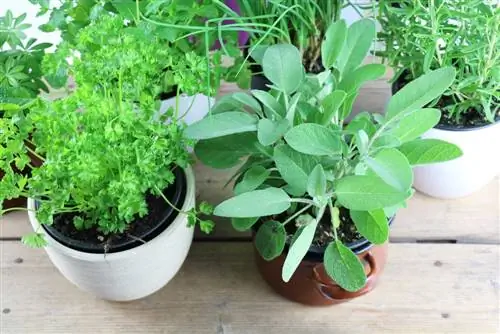- Author admin [email protected].
- Public 2023-12-17 03:39.
- Last modified 2025-01-24 12:45.
The boar's rue has the botanical name Artemisia abrotanum and belongs to the daisy family. The plant is also colloquially known as cola herb and is closely related to mugwort, tarragon and wormwood. The cola bush has been known as a popular aromatic and aromatic herb since ancient times. With the right care and the right location conditions, the heat-loving plant can also be grown successfully in this country.
Sowing & Planting
The cola herb is easy to sow and this process is usually very reliable. However, it is not always possible to harvest seeds from specimens growing in this country, as most often do not bloom in the local climate. If you live in high mountain areas, you should first prefer young plants indoors and only release them in late spring. The cola bush is suitable for individual planting, group planting and for cultivation in planters. However, it is always important to ensure that there is sufficient distance when planting, as the plant tends to overgrow. Otherwise, the neighboring plants will quickly feel threatened. However, many useful and ornamental plants benefit from boar's rue because it produces essential oils that keep unwelcome predators at a distance. However, Artemisia abrotanum should not grow too close to other medicinal plants. Its leaves contain growth-inhibiting substances that can be transferred to neighboring medicinal plants.
- Perform sowing in April
- Cola herb is a light germinator
- Only scatter seeds loosely on the ground
- Then press carefully and do not cover
- Afterwards keep the soil slightly moist
- Planting of early specimens takes place in spring
- In colder regions only carry out after the Ice Saints
- Maintain a planting distance of at least 50 cm
- Cola bush reaches a size of up to 1.50 m
- Also grows extremely wide
Location & plant substrate
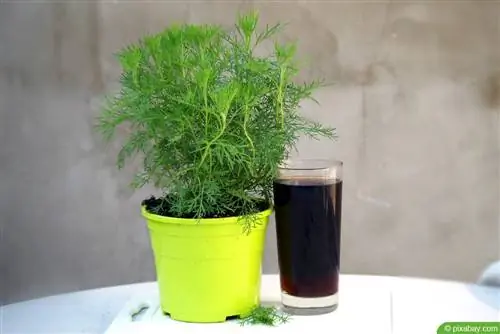
The boar's rue has its original home in the Near East, so it is used to warm and often even very hot local conditions. For this reason, the cola herb does not thrive in shady and cool places, and it also cannot tolerate soil that is too moist and compacted. In this case, the substrate must be loosened and improved, either with pumice, gravel, sand, stones or zeolite. In a place that is too dark, there is often no flowering, just like after a cold, wet spring and summer. The plant needs a lot of sun to produce beautiful flowers in summer. It is also important to have enough space for neighboring plants. The plant used to decorate the edges of spice and herb beds in many cottage gardens. Artemisia abrotanum also fits very well in apothecary gardens, in the courtyard of country houses and in Mediterranean-style gardens.
- Warm and full sun locations are ideal
- Make sure conditions are sheltered from the wind
- Regions with mild weather conditions are optimal
- Grows well in wine-growing regions
- Good for rock gardens
- Cultivation possible in a flower pot on a balcony or terrace
- Prefers calcareous, permeable and humus-rich soils
- Likes rocky to sandy soil conditions
- Good is a slightly alkaline to neutral pH value
Note:
If the soil is very poor in lime, it is a good idea to enrich it with garden lime from specialist retailers.
Watering & Fertilizing
The boar's rue copes much better with dryness than with too much moisture, which is why the plant should not be watered excessively. When cultivated in the garden bed, the normal rainfall is usually sufficient for the cola herb. However, it is advisable to supplemental watering during the extremely hot and dry summer months. If Artemisia abrotanum is in a pot on the covered balcony or terrace, additional watering units are also required. In addition, the plant is a weak feeder, so it does not require regular fertilizer applications. However, it is helpful to prepare the soil with a light fertilizer when planting. In this way, the cola plant finds a balanced nutrient content in the substrate.
- Water only moderately, only when the top layer of soil is dry
- Tolerates hard tap water
- Keep plant substrate dry to slightly moist
- Covers well with occasional dry periods
- Absolutely dislike waterlogging
- Water potted plants more often
- Root ball must never dry out completely
- Low nutrient requirements
- Fertilize about once a year in spring
- Horn shavings or compost are ideal as fertilizers
- Use lime-containing slow-release fertilizer when kept in containers
Cutting
If there is sufficient space, cutting the Eberraute is not necessary. However, pruning is recommended in order to bring the Artemisia abrotanum into shape and to keep overgrown areas under control. Otherwise, neighboring plants will quickly be affected and prevented from growing. In high mountain areas, pruning in late autumn also makes sense so that the frosty temperatures do not damage the plant. After that, the cola bush will not grow as high and wide next year; the growth will remain rather small and manageable. That's why extreme winter pruning is also suitable for potted plants that grow in smaller containers.
- Carry out shaping pruning in spring
- Remove faded and dried plant parts
- Radical pruning before winter makes sense
- Cut the plant down to the ground
- Sprouts again in spring
- Only use sharp cutting tools
- Disinfect cutting surfaces well beforehand
Propagate
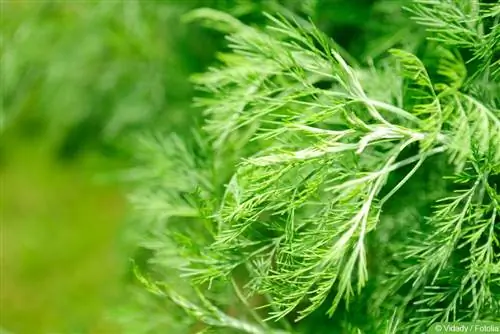
The cola herb can be propagated by cuttings and dividing the rootstock. However, it should be borne in mind that when propagating with cuttings, it takes a relatively long time for roots to form. There is no guaranteed success with this method. The shoots that arise from pruning in spring can be used for this. Dividing the rootstock usually works without any problems. However, care must be taken to handle the plants gently so as not to injure them unnecessarily.
- Cut long shoots with shoot tips in spring
- Slightly woody cuttings are ideal
- Place in pot with moist plant substrate and some sand
- Put the transparent film and bag over the container
- Works as a mini greenhouse
- In mild regions, stick directly into the ground
- Alternatively share rootstock
- Take the plant and its roots out of the ground
- Carefully expose roots
- Then divide and plant again
Leaves & Flowering Time
The boar's rue is a perennial and wintergreen subshrub that exudes a strongly aromatic scent. The cola bush forms a strong rootstock that can branch out widely in the ground. At first the shoots grow upright and after a while branch upwards in a panicle-like form. In addition, the stems become woody from below over time. With good site conditions and optimal care, vigorous growth quickly occurs, which is why cutting is essential. Because of their wide range of uses, harvesting the leaves is worthwhile. In this way the growth is kept manageable.
- Grows about 70-150 cm high and about 60 cm wide
- Forms finely pinnate and silvery-green leaves
- Foliage is narrow and alternate
- Leaves are covered with many scent glands
- Exude a sweet, lemony scent
- Flowering time is from July to October
- Spherical flower heads grow in dense panicles
- But flowers are only 3-4 mm large
- Flower color is pale yellow to green
Harvest & Use
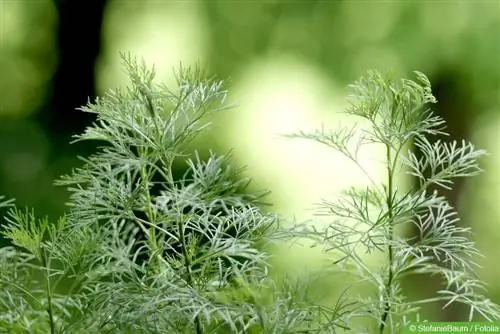
The cola herb has been used for many thousands of years, as a herb in the kitchen and as a medicinal plant for he alth problems. It is also suitable as a room scent due to its intense fragrances. The tender shoot tips of the plant are used, which can be harvested fresh all summer long. The leaves produce the highest active ingredient content in the months of July and August. However, due to its essential oils, the herb can only be used very sparingly in the kitchen. Before use, the shoot tips should dry in an airy place. If used in the kitchen, the dried herb should be stored in a well-sealed container. In addition, the cola bush is used in many areas in the household after drying.
- Shoot tips smell like lemon
- Tastes slightly bitter like Cola
- Goes well with dark sauces and roasts
- Fattery dishes in particular benefit from the addition
- Dry the herb and use it as potpourri
- Spicy leaves keep insects away with strong smell
- Packaged in small bags, the herb can be used in many different ways
- Fragrance prevents voracious moths in the cupboard
- Can be used as a flea repellent when keeping animals
- Has healing effects on the human body
- Brew as tea and consume regularly
- Stimulates the appetite and strengthens the stomach
- Promotes menstruation and helps against cramps
- Suitable for making a dewormer
Tip:
The cola herb can be used to make a bitter tonic, which stimulates digestion and can alleviate the symptoms of irritable bowel syndrome.
Wintering
The cola bush is only partially hardy because the plant is originally native to warm countries. Therefore, low temperatures below zero and long-lasting frost can have a severe impact on it. Especially in high mountain areas with a long and frosty winter, the plant relies on additional protection from the cold. In contrast, the plant does not need additional protection in regions with a mild winter. However, it is recommended to protect the soil from excessive moisture in winter. In addition, the plant should be cut back close to the ground in the garden bed if harsh winters are imminent. The roots also need to be protected from extreme frost. If the cola herb is cultivated in a bucket, it is a good idea to overwinter in a winter quarters.
- Wrap heavily trimmed plants with plant fleece
- Mulching soil with autumn leaves
- Lay brushwood above the roots
- Wrap the buckets left outside in fleece
- Bucket should be hardy
- Place the container on the Styrofoam mat
- Place in a protected corner, ideal in front of a sunny wall
- Alternatively move to an unheated winter garden
- A garden house or bright attic is also possible
Note:
Clay pots look nice, but are not suitable for extreme frost as these vessels can break apart.
Diseases & Pests

Diseases and pests are relatively rare in the cola bush. Thanks to the essential oils, the plant even deters pests that could also attack neighboring plants. That's why the cola herb is often found in mixed cultures between other garden plants. In this way, the cola bush uses its strong fragrance to keep, among other things, the dreaded cabbage white butterfly away from cabbage. However, with incorrect care and unsuitable site conditions, certain pests can establish themselves more easily, for example various types of aphids. Their excretions shine as sticky honeydew on which sooty mold fungi can settle. Since the sooty mold fungi further weaken Artemisia abrotanum, appropriate measures to combat them are necessary as soon as possible. In addition, the roots are often damaged by waterlogging, so that the plant withers and dies.
- Generally very robust plant
- Weakened specimens are susceptible to aphids
- Cause suction to damage leaves and shoots
- Can be recognized by deformed shoot tips
- Indications are also curled leaves that yellow and dry up
- Rinse pests with a sharp jet of water
- Hose affected areas with a solution of water and soap
- Use chemical antidotes only in extreme emergencies


